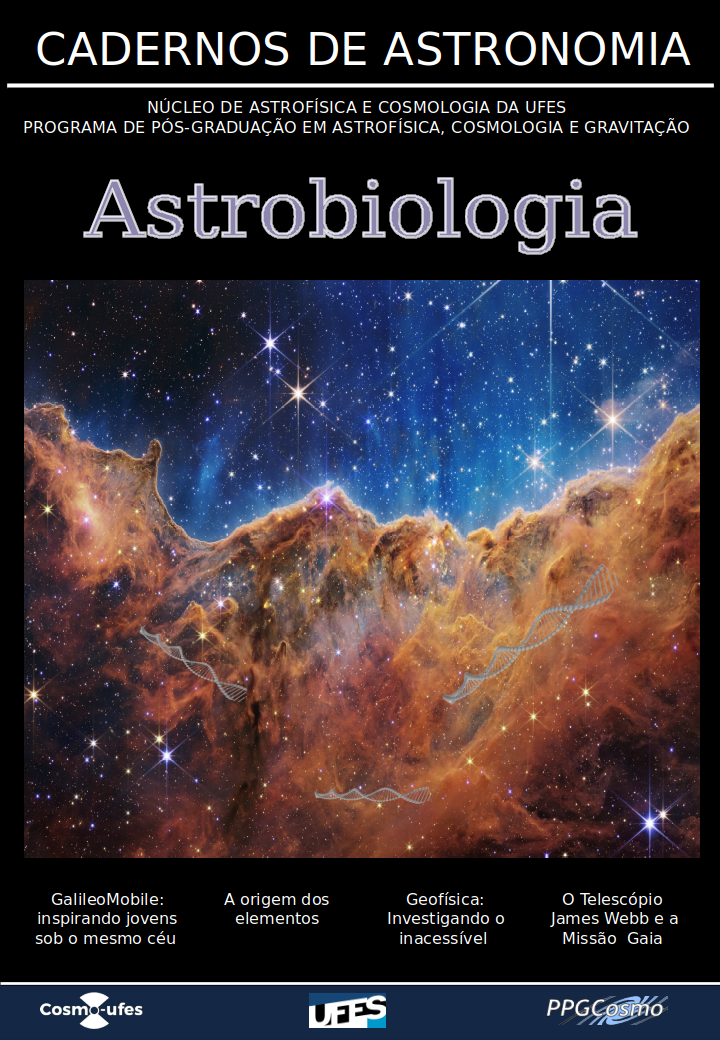Search for extraterrestrial life: habitability of the planetary system Gliese 667C
DOI:
https://doi.org/10.47456/Cad.Astro.v3n2.38324Keywords:
astrobiology, Gliese 667C, exoplanets, habitability, life emergencyAbstract
In this short paper are discussed the habitability conditions of exoplanets and, in particular, those affecting directly the presence of liquid water at the surface. The climate of planets depends strongly on the presence of an atmosphere, on the greenhouse gases and on the carbon-silicate cycle, which guarantees the climate stability over geological timescales. These ideas are applied to the planetary system present in Gliese 667C constituted by five “super-Earths”. The present analysis suggests that only Gliese 667C c has climate conditions adequate for the emergence of life.
References
N. R. Pace, The universal nature of biochemistry, Proc. Natl. Acad. Sci. U. S. A. 98(3), 805 (2001).
T. Shi et al., Characterization of viable bacteria from siberian permafrost by 16S rDNA sequencing, Microb. Ecol. 33(3), 169 (1997).
R. J. Cano e M. K. Borucki, Revival and identification of bacterial spores in 25 to 40 million-year-old dominican amber, Science 268(5213), 1060 (1995).
R. Pascal, Suitable energetic conditions for dynamic chemical complexity and the living state, J. Syst. Chem. 3(1), 3 (2012).
K. I. Cunningham et al., Bacteria, fungi and biokarst in lechuguilla cave, carlsbad caverns national park, new mexico, Environ. Geol. 25(1), 2 (1995).
R. Cavicchioli, Extremophiles and the search for extraterrestrial life, Astrobiology 2(3), 281 (2002).
C. T. Unterborn et al., Inward migration of the TRAPPIST-1 planets as inferred from their water-rich compositions, Nat. Astron. 2(4), 297 (2018).
G. A. L. Coleman et al., Pebbles versus planetesimals: the case of Trappist-1, Astron. Astrophys. 631, A7 (2019).
F. Masset e M. Snellgrove, Reversing type II migration: resonance trapping of a lighter giant protoplanet, Monthly Notices of the Royal Astronomical Society 320(4), L55 (2001).
B. J. Foley, The role of plate tectonic–climate coupling and exposed land area in the development of habitable climates on rocky planets, The Astrophysical Journal 812(1), 36 (2015).
K. Menou, Climate stability of habitable Earth-like planets, Earth Planet. Sci. Lett. 429, 20 (2015).
J. Haqq-Misra et al., Limit cycles can reduce the width of the habitable zone, Astrophys. J. 827(2), 120 (2016).
T. Gerlach, Volcanic versus anthropogenic carbon dioxide, Eos, Transactions American Geophysical Union 92(24), 201 (2011).
R. A. Berner, GEOCARB II; a revised model of atmospheric CO2 over phanerozoic time, Am. J. Sci. 294(1), 56 (1994).
R. K. Kopparapu et al., Habitable zones around main-sequence stars: Dependence on planetary mass, Astrophys. J. Lett. 787(2), L29 (2014).
R. kumar Kopparapu et al., Habitable moist atmospheres on terrestrial planets near the inner edge of the habitable zone around m dwarfs, The Astrophysical Journal 845(1), 5 (2017).
A. D. D. Genio et al., Albedos, equilibrium temperatures, and surface temperatures of habitable planets, The Astrophysical Journal 884(1), 75 (2019).
E. T. Wolf et al., Constraints on climate and habitability for Earth-like exoplanets determined from a general circulation model, The Astrophysical Journal 837(2), 107 (2017).
J. A. de Freitas Pacheco, Vida no Universo (EDUSP, São Paulo, 2020).
E. Agol et al., Refining the transit-timing and photometric analysis of TRAPPIST-1: Masses, radii, densities, dynamics, and ephemerides, The Planetary Science Journal 2(1), 1 (2021).
G. Anglada-Escudé et al., A dynamically-packed planetary system around GJ 667C with three super-earths in its habitable zone, Astron. Astrophys. 556, A126 (2013).
M. A. Thompson et al., Composition of terrestrial exoplanet atmospheres from meteorite outgassing experiments, Nat. Astron. 5(6), 575 (2021).
A. Tsuchiyama et al., Discovery of primitive CO2-bearing fluid in an aqueously altered carbonaceous chondrite, Sci. Adv. 7(17) (2021).
E. W. Schwieterman et al., A limited habitable zone for complex life, The Astrophysical Journal 878(1), 19 (2019).
D. S. Abbot, N. B. Cowan e F. J. Ciesla, Indication of insensitivity of planetary weathering behavior and habitable zone to surface land fraction, The Astrophysical Journal 756(2), 178 (2012).
L. R. Kump, J. F. Kasting e R. G. Crane, Earth system, the: Pearson new international edition (Pearson Education, Londres, 2013), 3ª ed.
N. E. Batalha et al., Climate cycling on early Mars caused by the carbonate–silicate cycle, Earth Planet. Sci. Lett. 455, 7 (2016).
A. Paradise et al., Habitable snowballs: Temperate land conditions, liquid water, and implications for CO2 weathering, J. Geophys. Res. Planets 124(8), 2087 (2019).
M. H. Hart, Habitable zones about Main Sequence Stars, Icarus 37(1), 351 (1979).
G. Gonzalez, The galactic habitable zone: Galactic chemical evolution, Icarus 152(1), 185 (2001).
J. F. Kasting e D. Catling, Evolution of a habitable planet, Annu. Rev. Astron. Astrophys. 41(1), 429 (2003).
J. F. Kasting, D. P. Whitmire e R. T. Reynolds, Habitable zones around Main Sequence Stars, Icarus 101(1), 108 (1993).
Downloads
Published
Issue
Section
License
Copyright (c) 2022 J. A. Freitas Pacheco

This work is licensed under a Creative Commons Attribution 4.0 International License.






